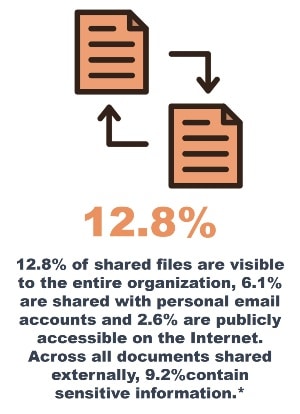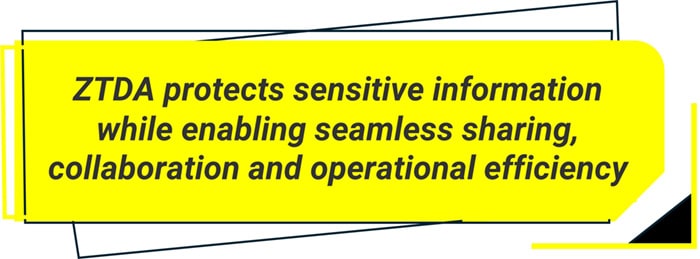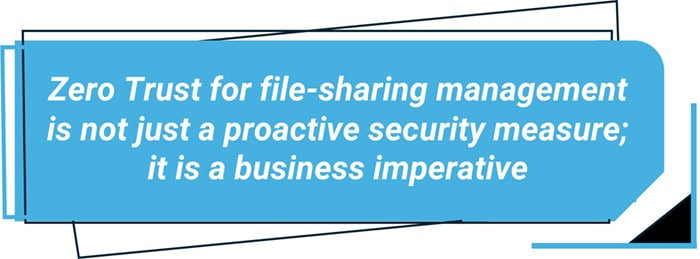
Benefits of zero trust file sharing management include enhanced data security, granular access control, compliance readiness, reduced insider threats, secure remote collaboration, and full audit visibility—here are 6 reasons why.
Benefits of Zero Trust File Sharing Management: 6 Key Reasons
Estimated reading time: 4 minutes
Table of Contents
Introduction: Strengthening Data Security and Compliance Through Advanced Zero Trust File Sharing Management

From ensuring data security to meeting stringent regulatory requirements, robust file-sharing management allows organizations to control what users can share, the storage repositories they can access, and the permissions associated with each user and file. By combining structured management practices with advanced security frameworks like Zero Trust Data Access (ZTDA), businesses can protect sensitive information while enabling seamless collaboration and operational efficiency.
This article explores the importance of zero trust based file-sharing management, detailing its benefits for security, compliance, efficiency, and governance, while highlighting how ZTDA enhances these practices to create a resilient, user-friendly system for managing shared data.

The Importance of File Sharing Management
Effective file-sharing management is critical in modern organizations to ensure operational efficiency, data security, and regulatory compliance. Here are the key reasons why managing what users can share, from which storage, and with what permissions is vital:
-
Data Security
-
-
- Prevent Unauthorized Access: By defining what users can share and from where, organizations minimize the risk of unauthorized data exposure.
- Reduce Insider Threats: Limiting permissions on a per-user and per-repository basis reduces the risk of malicious or accidental data leakage.
- Zero Trust Principle: Aligning permissions with zero trust principles ensures that only explicitly authorized users can access or share specific data.
-
-
Compliance and Auditability
-
-
- Regulatory Compliance: Industries such as healthcare, finance, and government are subject to strict regulations (e.g., GDPR, HIPAA). Proper file sharing management ensures adherence to these standards by controlling and tracking data sharing.
- Audit Trails: Tracking who shared what, from which repository, and with what permissions simplifies auditing processes and demonstrates compliance to regulators.
-
-
Operational Efficiency
-
-
- Role-Based Access Control: Assigning permissions based on roles or responsibilities reduces administrative overhead and ensures employees only access and share data relevant to their work.
- Streamlined Collaboration: Managing file sharing effectively ensures that employees have the access they need without excessive restrictions that can hinder collaboration.
-
-
Data Governance
-
-
- Prevent Shadow IT: Centralizing file-sharing management ensures users don’t resort to unapproved tools or services, which can compromise security and compliance.
- Control Over Data Lifecycle: Permissions can be tied to policies governing data retention, access review, and expiration, ensuring that data is shared responsibly.
-
-
Customizable User Permissions
-
-
- Granular Control: Enabling fine-grained control over permissions—such as view-only access, edit rights, or full ownership—helps ensure that shared files are used appropriately.
- Repository-Specific Permissions: Allowing permissions to vary by storage type or repository ensures alignment with organizational policies for data stored on-premises, in the cloud, or in hybrid environments.
-
-
Incident Response and Risk Mitigation
-
-
- Rapid Revocation: If a user leaves the company or their role changes, quickly revoking or modifying sharing permissions reduces the risk of lingering vulnerabilities.
- Breach Containment: By limiting what users can share, organizations can contain the impact of a breach, as compromised credentials won’t grant unlimited access to sensitive data.
-
The Benefits Zero Trust File Sharing Management Best Practices
Zero Trust Data Access (ZTDA) is a security framework that assumes no implicit trust in users, or devices, regardless of whether they are inside or outside the organization’s network. Instead, it enforces stringent access controls and user verification for every action. Applying ZTDA to file-sharing management enhances security and aligns with best practices in the following ways:

Granular Access Control
-
-
- Least Privilege Principle: ZTDA enforces least privilege access, such that users can only share files and access storage repositories they need for their role. This minimizes the risk of accidental or malicious misuse of sensitive data.
- Per-File Permissions: Rather than blanket access to entire directories or repositories, ZTDA allows organizations to define sharing permissions at the file level, improving control.
-
-
Minimized Attack Surface
-
-
- Data Access Segmentation: ZTDA limits users’ ability to access or share files only from authorized storage repositories. This segmentation prevents attackers from exploiting excessive access rights to move laterally within systems.
- Zero Standing Privileges: Temporary, just-in-time permissions reduce persistent access risks, ensuring users and systems only have access during the time and for the task required.
-
-
Enhanced Data Security
-
-
- End-to-End Encryption: ZTDA ensures that data remains encrypted during transit, protecting sensitive information even during file sharing.
- Controlled Sharing: By tightly controlling sharing options, ZTDA reduces the likelihood of data being shared with unauthorized external parties.
-
-
Improved Monitoring and Auditing
-
-
- Comprehensive Logs: ZTDA generates detailed logs of who accessed or shared what, and from which repository. This facilitates compliance reporting and breach investigation.
- Behavioral Analytics: ZTDA helps identify and respond to anomalous behavior indicative of potential security threats by continuously monitoring usage patterns and exporting to a SIEM.
-
-
Regulatory Compliance and Governance
-
-
- Regulatory Alignment: ZTDA aligns with frameworks like GDPR, CCPA, and HIPAA by enforcing stringent controls over data access and sharing.
- Policy Enforcement: Organizations can enforce data governance policies.
-
-
User-Centric Design Without Sacrificing Security
-
-
- Seamless User Experience: Despite its robust security measures, ZTDA ensures a user-friendly interface that enables secure and efficient file sharing without unnecessary complexity.
- Controlled Collaboration: Teams can collaborate while maintaining strict data access controls, fostering productivity without compromising security.
-
| Benefit | How It Helps |
| Data Protection | Prevents unauthorized downloads or sharing |
| Access Policies | Roles-based, contextual controls |
| Compliance | Ensures GDPR, HIPAA, CCPA tracking and enforcement |
| Insider Threat Safety | Stops misuse by limiting file access |
| Remote Collaboration | Secure access without moving data to cloud |
| Audit Logging | Full visibility into file activity |
Conclusion: Adopting Zero Trust File-Sharing Management
As digital collaboration continues to evolve, so too must the measures organizations take to protect sensitive information while maintaining operational efficiency. Zero Trust Data Access (ZTDA) serves as a critical foundation for effective file-sharing management, enabling businesses to enforce least privilege access, enhance data security, and ensure regulatory compliance without compromising productivity.
By implementing ZTDA principles, organizations gain the ability to minimize risks such as unauthorized access, insider threats, and data breaches, while fostering streamlined collaboration and maintaining control over the data lifecycle. Zero trust solutions like FileFlex Enterprise demonstrate how advanced file-sharing frameworks can integrate seamlessly into existing workflows, providing granular control and robust security tailored to modern business needs.
Ultimately, adopting Zero Trust for file-sharing management is not just a proactive security measure; it is a business imperative that positions organizations for long-term success in a highly connected and data-driven world.
For related articles see Why Zero Trust Data Access User Management is Crucial for IT, Top 8 Reasons Your Organization Needs Zero Trust Activity Tracking, Top 8 Reasons for Zero Trust Storage Management and Embracing Zero Trust Data Access for IT-Controlled Chain-of-Command.
Learn More About FileFlex Sign Up for a Free TrialFrequently Asked Questions
What is zero trust file sharing management?
Zero trust file sharing management applies continuous verification, least-privilege access, and strict data governance to every file-sharing interaction—ensuring only verified users and devices can access or share sensitive data.
What are the benefits of zero trust file sharing management?
Key benefits include enhanced data protection, prevention of insider threats, full auditability, and compliance with regulations like HIPAA, GDPR, and CCPA—all without requiring a VPN or centralized cloud repository.
How is this different from traditional file sharing tools?
Traditional tools focus on perimeter security and broad user access. Zero trust file sharing restricts access to only those who are continuously verified and authorized, reducing data leakage and lateral movement risk.
How does FileFlex support zero trust file sharing?
FileFlex enforces Zero Trust Data Access (ZTDA) by verifying identity, applying file-level access controls, logging all activity, and keeping data in place—making it a secure platform for compliant file sharing and collaboration.